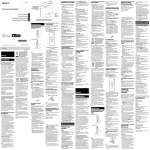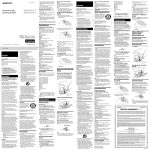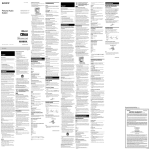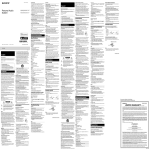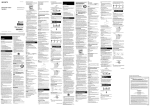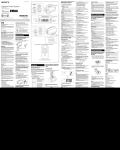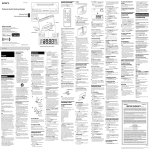Download Sony RDP-M7IPBLKN
Transcript
Important Safety Instructions 4-461-833-11(1) English Personal Audio System Operating Instructions US Manual de instrucciones ES Owner’s Record The model number and the serial number are located on the bottom. Record the serial number in the space provided below. Refer to them whenever you call upon your Sony dealer regarding this product. Model No. RDP-M7iPN Serial No._________________________________ For customers in the USA Please register this product on line at http://www.sony.com/productregistration Proper registration will enable us to send you periodic mailings about new products, services and other important announcements. Registering your product will also allow us to contact you in the unlikely event that the product needs adjustment or modification. Thank you. WARNING To reduce the risk of fire or electric shock, do not expose this apparatus to rain or moisture. To reduce the risk of fire, do not cover the ventilation of the apparatus with newspapers, tablecloths, curtains, etc. And do not place lighted candles on the apparatus. To reduce the risk of fire or electric shock, do not expose this apparatus to dripping or splashing, and do not place objects filled with liquids, such as vases, on the apparatus. Do not install the appliance in a confined space, such as a bookcase or built-in cabinet. ©2013 Sony Corporation Printed in China RDP-M7iPN This warranty is valid only in the United States. Esta garantía es válida únicamente en los Estados Unidos. Do not expose the batteries (battery pack or batteries installed) to excessive heat such as sunshine, fire or the like for a long time. As the main plug of AC adaptor is used to disconnect the AC adaptor from the mains, connect it to an easily accessible AC outlet. Should you notice an abnormality in it, disconnect it from the AC outlet immediately. The unit is not disconnected from the AC power source (mains) as long as it is connected to the wall outlet, even if the unit itself has been turned off. The nameplate and important information concerning safety are located on the bottom exterior of the main unit and on the surface of the AC adaptor. You are cautioned that any changes or modifications not expressly approved in this manual could void your authority to operate this equipment. CAUTION Danger of explosion if battery is incorrectly replaced. Replace only with the same type. NOTE This equipment has been tested and found to comply with the limits for a Class B digital device, pursuant to Part 15 of the FCC Rules. These limits are designed to provide reasonable protection against harmful interference in a residential installation. This equipment generates, uses and can radiate radio frequency energy and, if not installed and used in accordance with the instructions, may cause harmful interference to radio communications. However, there is no guarantee that interference will not occur in a particular installation. If this equipment does cause harmful interference to radio or television reception, which can be determined by turning the equipment off and on, the user is encouraged to try to correct the interference by one or more of the following measures: —Reorient or relocate the receiving antenna. —Increase the separation between the equipment and receiver. —Connect the equipment into an outlet on a circuit different from that to which the receiver is connected. —Consult the dealer or an experienced radio/TV technician for help. WARNING Replace the battery for the remote control with a Sony CR2025 lithium battery only. Use of another battery may present a risk of fire or explosion. Battery may explode if mistreated. Do not recharge, disassemble or dispose of in fire. Dispose of used battery promptly, according to local environmental laws and guidelines in force. Keep away from children. 1) 2) 3) 4) 5) 6) 7) Read these instructions. Keep these instructions. Heed all warnings. Follow all instructions. Do not use this apparatus near water. Clean only with dry cloth. Do not block any ventilation openings. Install in accordance with the manufacturer’s instructions. 8) Do not install near any heat sources such as radiators, heat registers, stoves, or other apparatus (including amplifiers) that produce heat. 9) Do not defeat the safety purpose of the polarized or grounding-type plug. A polarized plug has two blades with one wider than the other. A grounding type plug has two blades and a third grounding prong. The wide blade or the third prong are provided for your safety. If the provided plug does not fit into your outlet, consult an electrician for replacement of the obsolete outlet. 10)Protect the power cord from being walked on or pinched particularly at plugs, convenience receptacles, and the point where they exit from the apparatus. 11)Only use attachments/accessories specified by the manufacturer. 12)Use only with the cart, stand, tripod, bracket, or table specified by the manufacturer, or sold with the apparatus. When a cart is used, use caution when moving the cart/apparatus combination to avoid injury from tip-over. 13)Unplug this apparatus during lightning storms or when unused for long periods of time. 14)Refer all servicing to qualified service personnel. Servicing is required when the apparatus has been damaged in any way, such as power-supply cord or plug is damaged, liquid has been spilled or objects have fallen into the apparatus, the apparatus has been exposed to rain or moisture, does not operate normally, or has been dropped. For the state of California USA only Perchlorate Material –special handling may apply, see www.dtsc.ca.gov/hazardouswaste/perchlorate Perchlorate Material: Lithium battery contains perchlorate Precautions To disconnect AC power, grasp the plug itself, not the cord. Since a strong magnet is used for the speaker, keep credit cards using magnetic coding or spring-wound watches, CRT-based TVs, or projectors, etc., away from the unit to prevent possible damage from the magnet. Do not leave the unit in a location near a heat source such as a radiator or airduct, or in a place subject to direct sunlight, excessive dust, mechanical vibration, or shock. Allow adequate air circulation to prevent internal heat build-up. Do not place the unit on a surface (a rug, a blanket, etc.) or near materials (a curtain) which might block the ventilation holes. Should any solid object or liquid fall into the unit, unplug the unit and have it checked by qualified personnel before operating it any further. Do not touch the unit with wet hands. Do not place the unit anywhere near water. NOTES ON LITHIUM BATTERY Wipe the battery with a dry cloth to assure a good contact. Be sure to observe the correct polarity when installing the battery. Do not hold the battery with metallic tweezers, otherwise a short-circuit may occur. Note In the Operating Instructions, “iPod” is used as a general reference to functions on an iPod or iPhone, unless otherwise specified by the text or illustrations. If you have any questions or problems concerning your unit, please consult your nearest Sony dealer. General Information Troubleshooting General There is no power. Make sure the AC adaptor is connected to the wall outlet firmly. Make sure the batteries are inserted correctly. Replace all the batteries with new ones if they are weak. There is no sound. Adjust VOLUME +/− (VOL +/− on the remote). There is noise. Make sure that the unit is not in the vicinity of in-use portable phones, etc. If you use an audio connecting cable, disconnect the cable when it is not in use. Two different music sources are mixed together during playback. Stop playback of either the iPod or the optional component. The OPR/BATT indicator flashes. The OPR/BATT indicator flashes when the unit receives a signal from the remote, or when the batteries are weak. In these cases, the flashing does not mean there is an error or fault. iPod There is no sound. Make sure the iPod is connected firmly. An operation is not performed. Make sure the iPod is connected firmly. Check that the iPod is compatible with this unit (see “Compatible iPod/iPhone models”). The iPod does not charge. Make sure the iPod is connected firmly. Make sure the AC adaptor is connected firmly. Check that the iPod is compatible with this unit (see “Compatible iPod/iPhone models”). Audio-in There is no sound. Make sure the audio connecting cable is connected firmly. Make sure that the connected component is on playback status. The sound is low. Check the volume of the connected optional component. Remote control The remote does not function. Replace the battery in the remote with a new one if it is weak. Make sure that you are pointing the remote at the remote sensor on the unit. Do not cover or place any objects just in front of the receiver. Remove any obstacles in the path of the remote and the unit. Make sure the remote sensor is not exposed to strong light such as direct sunlight or fluorescent lamp light. If the problem persists, consult your nearest Sony dealer. Specifications AUDIO POWER SPECIFICATIONS POWER OUTPUT AND TOTAL HARMONIC DISTORTION: With 6 ohm loads both channels driven, from 150 Hz - 10,000 Hz; rated 1 watts per channel minimum RMS power, with no more than 10% total harmonic distortion. iPod Rated voltage: DC 5 V Rated current: Max. 1 A General Speaker Approx. 50 mm (2 inches) dia. × 2 Input AUDIO IN jack (ø 3.5 mm stereo minijack) Input impedance: 10 kΩ Standard input level: 245 mV Power output 2 W + 2 W (at 10% harmonic distortion) Power source Rated external power source: DC IN 6V, 1.3 A (With supplied AC adaptor (AC 120 V, 60 Hz)) or 4 × AAA/LR03 type batteries Battery life: Approx. 10 hours (Sony manufactured AAA/ LR03 alkaline batteries) Approx. 8 hours (Sony manufactured NH-AAA rechargeable batteries) Dimensions Approx. 226 mm × 165 mm × 151 mm (w/h/d) 9 inches × 6 1/2 inches × 6 inches (Including projecting parts and controls) Mass Approx. 1.1 kg (2 lb 7 oz) (Including batteries) Supplied accessories AC adaptor (1) Remote control (with a lithium battery) (1) Operating Instructions (1) Design and specifications are subject to change without notice. Preparations Power source You can use this unit with mains electricity or with batteries. ADVERTENCIA Español Por favor lea detalladamente este manual de instrucciones antes de conectar y operar este equipo. Recuerde que un mal uso de su aparato podría anular la garantía. Registro del propietario El número de modelo y el número de serie se encuentran en la parte inferior. Anote el número de serie en el espacio que se proporciona a continuación. Consúltelos siempre que llame a un distribuidor Sony en relación con este producto. N.º de modelo RDP-M7iPN N.º de serie_ ______________________________ Auto power off After playback of an iPod (or component connected to the AUDIO IN jack) has finished, if no operation is performed for about 20 minutes, the unit will automatically turn off. To use AC adaptor Connect the supplied AC adaptor to the DC IN 6V jack on the back of this unit firmly, and then plug the adaptor into a wall outlet. Note on the AC adaptor When operating the unit with internal batteries, remove the AC adaptor from the wall outlet and the DC IN 6V jack. Make sure that the plug of the external power source is disconnected before operating the unit. Use the supplied Sony AC adaptor only. The polarity of the plugs of other manufacturers may be different. Failure to use the supplied AC adaptor may cause the unit to malfunction. To use batteries Insert four AAA/LR03 alkaline batteries, or four NH-AAA rechargeable batteries (not supplied). When to replace the batteries When the batteries are weak, the OPR/BATT indicator will become faint, and the sound may be distorted. Notes on batteries Manganese batteries cannot be used. The unit cannot recharge any batteries. Do not carry batteries with coins or other metallic objects. It can generate heat if the positive and negative terminals of the batteries are accidentally contacted by a metallic object. Be sure to observe the correct polarity when installing the battery. If you are not going to use the unit for a long time, remove the batteries to avoid damage from battery leakage and corrosion. Do not use different types of batteries at the same time. When you replace the batteries, replace all of them with new ones. Battery performance depends on manufacturer and type, and battery life may be reduced, especially when used in low temperature. Continued on the reverse side Para clientes en los Estados Unidos Registre este producto en línea en http://www.sony.com/productregistration Un registro adecuado nos permitirá enviarle correos periódicos sobre nuevos productos, servicios y otros anuncios importantes. El registro de su producto también nos permitirá comunicarnos con usted en el caso improbable de que el producto necesite ajuste o modificación. Gracias. ADVERTENCIA Para reducir el riesgo de incendio o descarga eléctrica, no exponga este aparato a la lluvia ni a la humedad. Para reducir el riesgo de incendio, no cubra los agujeros de ventilación del aparato con periódicos, manteles, cortinas, etc., y no ponga velas encendidas encima del aparato. Para reducir el riesgo de incendio o descarga eléctrica, no exponga nunca el aparato a salpicaduras ni coloque sobre él objetos que contengan líquido, como jarrones. No instale el aparato en un espacio cerrado, como una estantería para libros o un armario empotrado. No exponga las baterías (el paquete de baterías o las baterías instaladas) a un calor excesivo como el sol directo, fuego o similar durante un período prolongado. Puesto que el enchufe principal del adaptador de ca se usa para desconectar este adaptador, es recomendable usar una toma de corriente de ca de fácil acceso. Si detecta algo anormal en el enchufe, desconecte de inmediato la unidad de la toma de corriente de ca. La unidad no estará desconectada de la fuente de alimentación de ca (toma de corriente) mientras esté conectada a la toma de pared, aunque esté apagada. En la parte inferior externa de la unidad principal y en la superficie del adaptador de ca se encuentran la placa de identificación e información importante sobre seguridad. Se le advierte que cualquier cambio o modificación no autorizada expresamente en este manual podrá anular la autorización que usted tiene para utilizar este equipo. PRECAUCIÓN Existe el riesgo de explosión si se cambia incorrectamente la batería. Cámbiela solo por otra del mismo tipo. NOTA Este equipo ha sido probado y se ha encontrado que cumple con los límites estipulados para un dispositivo digital de Clase B, en conformidad con el apartado 15 de las normas de la FCC. Estos límites están designados para ofrecer protección razonable contra las interferencias nocivas en una instalación residencial. Este equipo genera, utiliza y puede radiar energía de radiofrecuencia y, si no se instala y utiliza de acuerdo con las instrucciones, podrá ocasionar interferencias nocivas para las comunicaciones de radio. Sin embargo, no hay garantía de que no vayan a ocurrir interferencias en una instalación en particular. Si este equipo ocasiona interferencias de radio nocivas para la recepción de radio o televisión, lo que podrá determinarse apagando y encendiendo el equipo, se sugiere que el usuario intente corregir las interferencias tomando una o más de las medidas siguientes: —Reoriente o reubique la antena de recepción. —Aumente la separación entre el equipo y receptor. —Conecte el equipo a una toma de corriente de un circuito diferente al que está conectado el receptor. —Consulte al distribuidor o a un técnico con experiencia en radio/TV para que le ayude. Reemplace la batería del control remoto únicamente por una batería de litio Sony CR2025. Si usa cualquier otra batería, habrá riesgo de incendio o explosión. La batería puede explotar si se utiliza en forma inadecuada. No la recargue, desarmar ni la arroje al fuego. Deseche la batería agotada de inmediato. De acuerdo con las leyes y directrices ambientales locales vigentes. Manténgala fuera del alcance de los niños. Instrucciones de seguridad importantes 1) 2) 3) 4) 5) 6) 7) Lea estas instrucciones. Guarde estas instrucciones. Preste atención a todas las advertencias. Siga todas las instrucciones. No utilice este aparato cerca del agua. Límpielo solamente con un paño seco. No bloquee ninguna abertura de ventilación. Instale el aparato de acuerdo con las instrucciones del fabricante. 8) No instale el aparato cerca de fuentes de calor como radiadores, rejillas de salida de calor, estufas, u otros aparatos (incluidos amplificadores) que produzcan calor. 9) No anule la función de seguridad de la clavija polarizada o de tipo con puesta a tierra. Una clavija polarizada tiene dos cuchillas con una más ancha que la otra. Una clavija de tipo con puesta a tierra tiene dos cuchillas y una tercera espiga de puesta a tierra. La cuchilla ancha o la tercera espiga están provistas para su seguridad. Si la clavija provista no encaja en su toma de corriente, consulte con un electricista para que le reemplace la toma de corriente obsoleta. 10)Proteja el cable de alimentación para impedir que pueda ser pisado o pinchado, particularmente en los enchufes, tomas de corriente con extensión eléctrica y puntos donde salen del aparato. 11)Utilice solamente aditamentos/accesorios especificados por el fabricante. 12)Utilícelo solamente con el carrito, estante, trípode, soporte, o mesa especificado por el fabricante, o vendido con el aparato. Cuando se utilice un carrito, tenga cuidado al mover la combinación de carrito/aparato para evitar que se vuelque y le ocasione heridas. 13)Desenchufe este aparato durante las tormentas eléctricas o cuando no lo vaya a utilizar durante largos periodos de tiempo. 14)Solicite toda asistencia técnica a personal cualificado. El servicio de reparación será necesario cuando el aparato haya sido dañado de cualquier forma, tal como cuando esté dañado el cable de alimentación o la clavija, se haya derramado líquido o hayan caído objetos al interior del aparato, el aparato haya sido expuesto a la lluvia o humedad, no funcione normalmente, o se haya dejado caer. Sólo para el estado de California, EE. UU. Material de perclorato: puede requerir una manipulación especial; consulte www.dtsc.ca.gov/hazardouswaste/perchlorate Material de perclorato: la batería de litio contiene perclorato Precauciones Para desconectar la unidad de ca del suministro de alimentación, tómela del enchufe, no del cable. Debido a que el altavoz utiliza un imán potente, mantenga las tarjetas de crédito que utilizan codificación magnética o los relojes de cuerda, televisores de tubos de rayos catódicos (CRT) o proyectores, etc. alejados de la unidad para evitar posibles daños causados por el imán. No coloque la unidad cerca de una fuente de calor, como un radiador o conducto de aire, o en un lugar que esté expuesto a la luz solar directa, polvo excesivo, vibración mecánica o golpes. Deje que el aire circule adecuadamente para evitar la acumulación interna de calor. No coloque la unidad sobre una superficie (tapete, manta, etc.) o cerca de materiales (cortinas) que puedan obstruir los orificios de ventilación. En caso de que un objeto sólido o líquido cayera sobre la unidad, desenchúfela y haga que la revise personal calificado antes de proseguir con su uso. No toque la unidad con las manos mojadas. No coloque la unidad cerca del agua. NOTAS SOBRE LA BATERÍA DE LITIO Limpie la batería con un paño seco para garantizar un contacto adecuado. Asegúrese de observar la polaridad al instalar la batería. No sostenga la batería con pinzas metálicas; de lo contrario, podría producirse un cortocircuito. Nota En el Manual de instrucciones, el término “iPod” hace referencia en general a las funciones de un iPod o iPhone, a menos que el texto o las ilustraciones especifiquen lo contrario. Si tiene alguna pregunta o problema en relación con su unidad, póngase en contacto con su distribuidor Sony más cercano. Información general Solución de problemas Generales No hay energía. Compruebe que el adaptador de ca esté bien conectado a la toma de pared. Asegúrese de que las baterías estén colocadas correctamente. Si están débiles, reemplace todas las baterías por unas nuevas. No hay sonido. Ajuste VOLUME +/− (VOL +/− en el control remoto). Hay ruido. Compruebe que no haya teléfonos móviles o dispositivos similares encendidos cerca de la unidad. Si usa un cable de conexión de audio, desconecte el cable cuando no se lo esté utilizando. Dos fuentes de música distintas se mezclan durante la reproducción. Detenga la reproducción del iPod o del componente opcional. El indicador OPR/BATT parpadea. El indicador OPR/BATT parpadea cuando la unidad recibe una señal del control remoto o cuando las baterías están débiles. En estos casos, el parpadeo no significa que haya un error o una falla. iPod No hay sonido. Asegúrese de que el iPod esté correctamente conectado. No se puede realizar ninguna operación. Asegúrese de que el iPod esté correctamente conectado. Verifique que el iPod sea compatible con esta unidad (ver “Modelos de iPod/iPhone compatibles”). El iPod no se carga. Asegúrese de que el iPod esté correctamente conectado. Asegúrese de que el adaptador de ca esté correctamente conectado. Verifique que el iPod sea compatible con esta unidad (ver “Modelos de iPod/iPhone compatibles”). Entrada de audio No hay sonido. Asegúrese de que el cable de conexión de audio esté correctamente conectado. Asegúrese de que el componente conectado se encuentre en un estado de reproducción. El sonido es bajo. Verifique el volumen del componente opcional conectado. Especificaciones ESPECIFICACIONES DE LA ALIMENTACIÓN DEL AUDIO POTENCIA DE SALIDA Y DISTORSIÓN ARMÓNICA TOTAL: Con cargas de 6 ohms, ambos canales dirigidos, de 150 a 10 000 Hz; potencia eficaz RMS mínima de 1 watts nominales por canal, con un máximo del 10% de distorsión armónica total. iPod Tensión nominal: cc 5 V Corriente nominal: Máx. 1 A Generales Altavoz Aprox. 50 mm (2 pulgadas) de diámetro. × 2 Entrada Toma AUDIO IN (minitoma estéreo de ø 3,5 mm) Impedancia de entrada: 10 kΩ Nivel de entrada estándar: 245 mV Salida de potencia 2 W + 2 W (con un 10% de distorsión armónica) Fuente de alimentación Fuente de alimentación externa nominal: Entrada de cc 6V, 1,3 A (con adaptador de ca suministrado (ca 120 V 60 Hz 12 W)) o 4 × baterías tipo AAA/ LR03 Vida útil de la batería: Aprox. 10 horas (baterías alcalinas AAA/LR03 fabricadas por Sony) Aprox. 8 horas (baterías recargables NH-AAA fabricadas por Sony) Dimensiones Aprox. 226 mm × 165 mm × 151 mm (an/al/prf) 9 pulgadas × 6 1/2 pulgadas × 6 pulgadas (incluye salientes y controles) Peso Aprox. 1,1 kg (2 libras 7 onzas) (baterías incluidas) Accesorios suministrados Adaptador de ca (1) Control remoto (con una batería de litio) (1) Manual de instrucciones (1) El diseño y las especificaciones están sujetos a cambios sin previo aviso. Preparaciones Fuente de alimentación Puede utilizar esta unidad con suministro de electricidad o con baterías. Apagado automático Una vez terminada una reproducción en un iPod (o un componente conectado a la toma AUDIO IN), si no se realiza ninguna operación en 20 minutos (aproximadamente), la unidad se apagará automáticamente. Para utilizar el adaptador de ca Conecte el adaptador de ca suministrado a la toma DC IN 6V (Entrada de cc 6V) que se encuentra en la parte trasera de esta unidad y enchúfelo a una toma de corriente. Nota sobre el adaptador de ca Cuando utilice la unidad con baterías internas, quite el adaptador de ca de la toma de la pared y de la toma DC IN 6V (Entrada de cc 6V). Asegúrese de que el enchufe de la fuente de alimentación externa esté desconectado antes de poner en funcionamiento la unidad. Utilice solo el adaptador de ca suministrado por Sony. Es posible que la polaridad de los enchufes de otros fabricantes sea diferente. Si no utiliza el adaptador de ca suministrado, la unidad podría averiarse. Control remoto El control remoto no funciona. Cambie la batería del control remoto por una nueva si no funciona correctamente. Apunte siempre con el control remoto al sensor de la unidad. No cubra ni coloque ningún objeto justo en frente del receptor . Aparte cualquier posible obstáculo entre el control remoto y la unidad. Asegúrese de que el sensor no esté expuesto a una luz demasiado fuerte, como la luz solar directa o la de una lámpara fluorescente. Si el problema continúa, consulte con su distribuidor Sony. Si no va a utilizar la unidad durante un período prolongado, quite las baterías para evitar el daño causado por fuga y corrosión. No utilice diferentes tipos de baterías al mismo tiempo. Cuando reemplace las baterías, reemplácelas todas por baterías nuevas. El rendimiento de la batería depende del fabricante y del tipo de batería y la vida útil puede reducirse, particularmente cuando se la utiliza a bajas temperaturas. Para utilizar las baterías Inserte cuatro baterías alcalinas AAA/LR03 o cuatro baterías recargables NH-AAA (no suministradas). Cuándo se deben cambiar las baterías Cuando las baterías estén débiles, el indicador OPR/BATT se volverá tenue y el sonido podría distorsionarse. Notas sobre las baterías No deben utilizarse baterías de manganeso. La unidad no puede recargar baterías. No lleve las baterías con monedas u otros objetos metálicos. Puede generar calor si las terminales positivas y negativas de las baterías entran en contacto accidentalmente con un objeto metálico. Asegúrese de observar la polaridad al instalar la batería. Continúa del otro lado iPod − VOLUME + Compatible iPod/ iPhone models / Startup Guide/Guía de inicio rápido The compatible iPod/iPhone models are as follows. Update the software of the iPod/iPhone to the latest version before using it with this unit. iPod touch (5th generation) iPod nano (7th generation)* iPhone 5 OPR/BATT indicator Indicador OPR/BATT Remote sensor Sensor remoto Dock connector Conector de la bandeja The VOLUME + and buttons have a tactile dot. Los botones VOLUME + y tienen un punto táctil. Remote control AAA/LR03 × 4 * Alkaline battery LR03 Manganese battery R03 * Alkaline batteries are not supplied. Manganese batteries (R03) cannot be used. The unit cannot recharge any batteries. Pilas alcalinas no suministradas. No se pueden usar pilas de manganeso (R03). La unidad no puede recargar ninguna pila. English Operations Before using the supplied remote for the first time, remove the insulation film. Aim the remote at the (Remote sensor) of the unit. The OPR/BATT indicator flashes when the remote’s signal is received. How to handle an iPod To set an iPod * The iPod nano (7th generation) cannot be controlled by the remote when the command of “MENU,” “,” “,” and “ENTER” is pressed. On copyrights iPhone, iPod, iPod nano, and iPod touch are trademarks of Apple Inc., registered in the U.S. and other countries. Lightning is a trademark of Apple Inc. “Made for iPod,” and “Made for iPhone” mean that an electronic accessory has been designed to connect specifically to iPod or iPhone, respectively, and has been certified by the developer to meet Apple performance standards. Apple is not responsible for the operation of this device or its compliance with safety and regulatory standards. Please note that the use of this accessory with iPod or iPhone may affect wireless performance. Note This unit is not specified for use with an iPad, and malfunction may result if used with one. 1 Set an iPod on the dock connector. To remove an iPod / (On/Standby) Turns the unit on/off. The OPR/BATT indicator lights up when the unit is turned on. When using batteries, press the / button on the unit. The / button of the remote works only when the AC adaptor is used. (Play/Pause) Start playing an iPod. Press again to pause/ resume playback. (Forward) Go to the next track. Press and hold while listening to the sound to locate a desired point. About App Operating an iPod The VOL + and buttons have a tactile dot. Notes An iPod in a case or cover can be set in this unit. However, if the case or cover interferes with the connection, remove the case or cover before setting the iPod on the dock connector. When placing or removing the iPod, hold it at the same angle as the dock connector on the unit. Do not pull the iPod forward too far. When placing or removing the iPod, hold the unit securely. Do not twist or bend the iPod as this may result in connector damage. Remove the iPod when transporting it; otherwise, a malfunction may result. (Backward) Go back to the previous track. During playback, this operation returns to the beginning of the current track. To go back to the previous track, press twice. Press and hold while listening to the sound to locate a desired point. MENU Go back to the previous menu. (Up)/ (Down) Select a menu item or track for playback. ENTER Execute the selected menu item or begin playback. VOL +/– (Volume plus/minus) Adjust the volume. The dock connector can be tilted slightly. For details, see “How to handle an iPod.” 2 Press . When using batteries, press / on the unit, then press . The iPod begins playback. You can operate the connected iPod via this unit or the iPod itself. Notes If a pop-up message appears on the display of the iPod touch or iPhone, see “About App.” If the battery of the iPod is extremely low, charge it for a while before operation. Sony cannot accept responsibility in the event that data recorded to an iPod is lost or damaged when using an iPod connected to this unit. For details of environmental conditions for operating the iPod, check the website of Apple Inc. To remove the iPod For details, see “How to handle an iPod.” To adjust the volume Press VOLUME +/− (VOL +/− on the remote). Tip The OPR/BATT indicator flashes three times when the sound is set to either maximum or minimum volume. With normal use, battery life (CR2025) should last for about 6 months. When the remote can no longer operate the unit, replace the battery with a new one. You can enjoy the sound from an optional component, such as a portable digital music player, through the speakers of this unit. Be sure to turn off the power of each component before making any connections. Note If you are not going to use the remote for a long time, remove the battery to avoid any damage that may be caused by leakage and corrosion. Operaciones Cómo manejar un iPod Para colocar un iPod 1 Firmly connect the line output jack of a portable digital music player (or other component) to the AUDIO IN jack on the back of the unit, using a suitable audio connecting cable (not supplied). 2 Press to turn on the unit. 3 Turn the connected component on. 4 Play the connected component. The sound from the connected component is output from the speakers of this unit. (Avanzar) Avance a la pista siguiente. Pulse sin soltar mientras escucha el sonido hasta llegar al punto que desee. (Retroceder) Vuelva a la pista anterior. Durante la reproducción, esta operación vuelve al principio de la pista actual. Para volver a la pista anterior, púlselo dos veces. Pulse sin soltar mientras escucha el sonido hasta llegar al punto que desee. MENU Vuelva al menú anterior. (Arriba)/ (Abajo) Seleccione un elemento de menú o una pista para reproducir. ENTER Active el elemento del menú seleccionado o inicie la reproducción. VOL +/– (Volumen más/menos) Ajuste el volumen. Para extraer un iPod Nota Algunas operaciones pueden no coincidir o no estar disponibles según el modelo de iPod. Cuándo se debe cambiar la batería En condiciones normales de uso, la vida útil de la batería (CR2025) debería ser de unos 6 meses. Cuando la unidad ya no funcione con el control remoto, sustituya la batería por una nueva. este lado hacia arriba Reproducción de un iPod 1 Coloque un iPod en el conector de la bandeja. El conector de la bandeja puede inclinarse un poco. Para más detalles, ver “Cómo manejar un iPod”. 2 Pulse . Cuando utilice baterías, presione / de la unidad, luego presione . El iPod comienza a reproducir. Puede utilizar el iPod conectado mediante los botones de la unidad o del propio iPod. Notas Si aparece un mensaje emergente en la pantalla del iPod touch o iPhone, consulte “Acerca de App”. Si la batería del iPod está casi agotada, cárguela antes de utilizarlo. Sony declina toda responsabilidad en el caso de la pérdida o corrupción de datos grabados en el iPod al utilizarlo conectado a esta unidad. Para obtener información detallada sobre las condiciones ambientales para utilizar el iPod, visite el sitio web de Apple Inc. Para extraer el iPod Para más detalles, ver “Cómo manejar un iPod”. Para ajustar el volumen Pulse VOLUME +/− (VOL +/− en el control remoto). Sugerencia El indicador OPR/BATT parpadea tres veces cuando el sonido se ajusta en el volumen máximo o mínimo. Para cargar un iPod (sólo ca) Notas En esta unidad, se puede colocar el iPod con su estuche o funda. Sin embargo, si el estuche o funda interfieren con la conexión, retírela antes de colocar el iPod en el conector de la bandeja. Cuando coloque o retire el iPod, sujételo en el mismo ángulo que el conector de la bandeja de la unidad. No tire del iPod demasiado hacia delante. Al colocar o extraer el iPod, sujete la unidad con firmeza. No gire ni incline el iPod ya que se podría dañar el conector. Extraiga el iPod al transportarlo; de otra manera se podrían causar daños. Nota Si no va a utilizar el control remoto durante un período de tiempo prolongado, retire la batería para evitar que se produzcan daños por fugas o corrosión. Modelos de iPod/ iPhone compatibles A continuación, se indican los modelos de iPod/ iPhone compatibles. Actualice el software del iPod/iPhone a la última versión antes de utilizar esta unidad. iPod touch (5ª generación) iPod nano (7ª generación)* iPhone 5 Control remoto Antes de utilizar el control remoto suministrado por primera vez, extraiga la película de aislamiento. Apunte el control remoto al (sensor remoto) de la unidad. El indicador OPR/BATT parpadea cuando se recibe la señal del control remoto. You can use the unit as a battery charger for an iPod when the power is supplied by the AC adaptor. Charging begins when the iPod is connected to the unit. The charging status appears in the display on the iPod. For details, refer to the user’s guide of the iPod. Connecting optional components side facing up A dedicated Dock App for iPod touch/iPhone available at Apple App Store. Search for “D-Sappli” and download the free App to find out more about the functions. Features D-Sappli includes various timer functions: Alarm, Music Play Timer, and Sleep Timer. You can set up to 10 alarms, using songs in iPod or Preset Sound in D-Sappli for the alarm sound. The Music Play Timer allows you to play/pause desired music at a desired time. The Sleep Timer allows you to specify a time at which to stop music playback. The Music Play Timer and Sleep Timer work in combination with the power supply of the unit. Music Play Timer, Sleep Timer and Alarm are available only when D-Sappli is activated. D-Sappli also includes a clock display enlarge feature. Notes If the App to link with this unit is not downloaded to your iPod touch/iPhone, a pop-up message prompting you to download D-Sappli may appear repeatedly. Deactivate the App’s link function to stop the pop-up message. To deactivate the App’s link function: Connect the AC adaptor, and then press / to turn off the unit. Remove your iPod touch/iPhone from the dock connector. While holding down , also press and hold / on the unit for at least 2 seconds. (The OPR/BATT indicator flashes twice when the function is deactivated.) To re-activate the App’s link function, repeat the above steps. (The OPR/BATT indicator flashes once when the function is activated.) Español To charge an iPod (AC only) Note Some operations may differ or may not be available for different models of iPod. When to replace the battery Notes The necessary type of audio connecting cable depends on the optional component. Make sure to use the correct type of cable. If the volume level is low, adjust the volume of the unit first. If the volume is still too low, adjust the volume of the connected component. When playing an optional component connected to the AUDIO IN jack, stop playback of an iPod. Disconnect the audio connecting cable from the unit when it is not in use. Los botones VOL + y tienen un punto táctil. / (Encendido/Modo de espera) Apaga/enciende la unidad. El indicador OPR/ BATT se enciende cuando se enciende la unidad. Cuando utilice las baterías, presione el botón / de la unidad. El botón / del control remoto funciona únicamente cuando se utiliza el adaptador de ca. (Reproducir/Pausa) Inicie la reproducción del iPod. Pulse de nuevo para pausar/reanudar la reproducción. * El iPod nano (7ª generación) no puede controlarse con control remoto cuando el comando de “MENU”, “”, “”, y "ENTER” está presionado. Sobre los derechos de autor iPhone, iPod, iPod nano y iPod touch son marcas comerciales de Apple Inc., registradas en los EE. UU. y otros países. Lightning es una marca comercial de Apple Inc. “Made for iPod” y “Made for iPhone” significa que un accesorio electrónico se diseñó para conectarse específicamente a un iPod o iPhone, respectivamente, y que cuenta con la certificación del desarrollador para cumplir con los estándares de rendimiento de Apple. Apple no se responsabiliza por el funcionamiento de este dispositivo ni por el cumplimiento de los estándares regulatorios y de seguridad. Tenga en cuenta que el uso de este accesorio con un iPod o iPhone puede afectar el rendimiento inalámbrico. Nota Esta unidad no está diseñada para usar con un iPad; esto podría causar un mal funcionamiento. Puede utilizar la unidad como un cargador de batería del iPod cuando el adaptador de ca suministre la energía. La carga comienza cuando el iPod se conecta a la unidad. El estado de carga aparece en la pantalla del iPod. Para obtener más información, consulte el manual del usuario del iPod. Conexión de componentes opcionales Es posible disfrutar del sonido de un componente opcional, como un reproductor de música digital portátil, a través de los altavoces de la unidad. Asegúrese de apagar todos los componentes antes de realizar las conexiones. 1 Conecte con firmeza la toma de salida de línea de un reproductor de música digital portátil (u otro componente) a la toma AUDIO IN de la parte trasera de la unidad mediante un cable de conexión de audio adecuado (no suministrado). 2 Pulse para encender la unidad. 3 Encienda el componente conectado. 4 Reproduzca el componente conectado. El sonido del componente conectado se emite a través de los altavoces de esta unidad. Notas El tipo de cable de conexión de audio requerido depende del componente opcional. Asegúrese de utilizar el cable correcto. Si el nivel del volumen es bajo, ajuste primero el volumen de la unidad. Si el volumen sigue siendo demasiado bajo, entonces ajuste el volumen del componente conectado. Cuando reproduzca un componente opcional conectado a la toma AUDIO IN, detenga la reproducción del iPod. Desconecte el cable de conexión de audio si no está utilizando la unidad. Acerca de App Existe una aplicación de bandeja específica disponible para iPod touch/iPhone en la tienda “Apple App Store”. Busque “D-Sappli” y descargue la aplicación gratuita para obtener más información sobre las funciones. Características “D-Sappli” incluye varias funciones de temporizador: alarma, “Music Play Timer” y “Sleep Timer”. Puede programar hasta 10 alarmas, y usar las canciones en el iPod o los sonidos preestablecidos en “D-Sappli” para el tono de alarma. “Music Play Timer” le permite reproducir y pausar la música que quiere y cuando quiere. “Sleep Timer” le permite especificar un horario para detener la reproducción de música. “Music Play Timer” y “Sleep Timer” funcionan en combinación con el suministro de energía de la unidad. Las funciones “Music Play Timer”, “Sleep Timer” y alarma están disponibles sólo cuando “D-Sappli” está activado. “D-Sappli” incluye a su vez una función de ampliación de la pantalla de reloj. Notas Si la App que se enlaza a esta unidad no se descargó al iPod touch/iPhone, aparecerá repetidamente un mensaje emergente instando al usuario a descargar “D-Sappli”. Desactive la función enlace de Apps para poner fin al mensaje emergente. Para desactivar la función enlace de Apps: Conecte el adaptador de ca y presione / para apagar la unidad. Extraiga su iPod touch/ iPhone del conector de la bandeja. Mientras mantiene apretado , también presione y sujete / de la unidad durante al menos 2 segundos. (El indicador OPR/BATT parpadea dos veces cuando la función está desactivada). Para volver a activar la función enlace de Apps, repita los pasos anteriores. (El indicador OPR/ BATT parpadea una vez cuando la función está activada).
This document in other languages
- español: Sony RDP-M7IPBLKN


